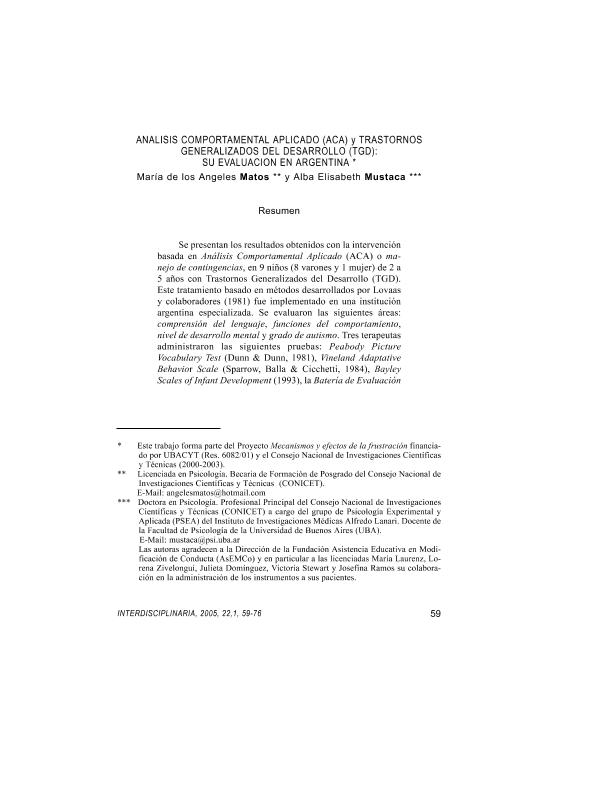Artículo
Se presentan los resultados obtenidos con la intervención basada en Análisis Comportamental Aplicado (ACA) o manejo de contingencias, en 9 niños (8 varones y 1 mujer) de 2 a 5 años con Trastornos Generalizados del Desarrollo (TGD). Este tratamiento basado en métodos desarrollados por Lovaas y colaboradores (1981) fue implementado en una institución argentina especializada. Se evaluaron las siguientes áreas: comprensión del lenguaje, funciones del comportamiento, nivel de desarrollo mental y grado de autismo. Tres terapeutas administraron las siguientes pruebas: Peabody Picture Vocabulary Test (Dunn & Dunn, 1981), Vineland Adaptative Behavior Scale (Sparrow, Balla & Cicchetti, 1984), Bayley Scales of Infant Development (1993), la Batería de Evaluación Kaufman para Niños (K.ABC) de Kaufman y Kaufman (1997) y The Childhood Autism Rating Scale (CARS) de Schopler, Reichler, DeVellis y Daly (1988). Los resultados fueron evaluados por una psicóloga que no había participado de la administración. Se utilizó un diseño intra-sujeto antes-después (inicio de la intervención y entre nueve y doce meses después) sin grupo control. Los datos se analizaron con Análisis de Variancia (ANOVA) de medidas repetidas. Siete participantes obtuvieron cambios positivos significativos en las cuatro áreas estudiadas: uno en tres áreas y uno en dos. Los mejores resultados se obtuvieron en funcionalidad del comportamiento (p < .004) y en dos de sus subdominios: autovalimiento (p < .006) y habilidades motrices (p < .001). También se observaron diferencias significativas en los otros dos subdominios: comunicación (p < .01) y socialización (p < .01). Las diferencias en lenguaje receptivo, funcionamiento intelectual y nivel de autismo también resultaron significativas: (p < .01), (p < .02) y (p < .04) respectivamente. The behavioral model has proven to be an effective treatment approach for people with Pervasive Developmental Disabilities -PDD- (Birnbrauer & Leach, 1993; Lovaas, 1987). It has enhanced intellectual, social and emotional functioning of that people that required less professional attention, as they grow older. This model considers that autism is an organically based disorder and that people with PDD have behavioral excesses (e.g. ritualistic behavior, self stimulation, tantrums, self injurious behaviors) and deficits (e.g. social attachment, language) that can be modified and maintained through time. The general aim of this study was to examine the effect of an intervention implemented by an Argentine specialized foundation. It evaluates the impact of a treatment based on Applied Behavior Analysis (ABA) on nine children (8 boys and one girl) between 2 and 5 years of chronological age. All the children met the criteria for autism or pervasive developmental disorders outlined in the Diagnostic and Statistical Manual of Mental Disorder (APA, 1994). The intervention was based on methods developed by Lovaas and collaborators (1981). It was intensive (the children were exposed to 30 hours of therapy per week during 9 to 12 months), home based, and highly structured. The skills where divided into small, discrete tasks and systematically rewarded or reinforced desired behaviors and ignored or discouraged inappropriate behaviors. All the data was recalled so that the assessment of the effectiveness of the treatment could be done. At the very beginning the instruction was one to one, the child worked along with a therapist. This emphasized the use of experimentally validated teaching approaches based mainly on operant conditioning principles such as shaping, chaining, discrimination training, and behavior management. When the child learned a new skill the therapist prompted him to respond appropriately and immediately reinforced each trial. The therapist faded prompts over subsequent trials until he only reinforced correct, unprompted responses. Once the skills were learned, the therapist worked to help the child maintain and generalize them to natural settings (as school, squares, markets), and acquire new skills in such settings. A single-subject design base line treatment was used. All children were evaluated at intake and between 9 and 12 months after treatment begun. Three examiners from the foundation assessed the following areas: receptive language, adaptive functioning, intellectual functioning and autism level. The instruments administered were, respectively: Peabody Picture Vocabulary (Dunn & Dunn, 1981), Vineland Adaptative Behavior Scale (Sparrow, Balla & Cicchetti, 1984), Bayley Scales of Infant Development (1993), Batería de Evaluación Kaufman para Niños -K.ABC- of Kaufman and Kaufman (1997) and The Childhood Autism Rating Scale -CARS- of Schopler, Reichler, DeVellis and Daly (1988). A clinical psychologist with expertise in autism carried out the assessment. The data collected was assessed with repeated measures Variance Analysis. The results showed that there was an improvement of the measures after the treatment and that 8 of the 9 children hadbenefited from it. The best outcome was in general adaptive functioning (p < .004), and in two of the domains: daily living skills (p < .006) and motor skills (p < .001). There were significant differences in the two other domains: communication (p < .01) and socialization (p < .01). The improvement in receptive language, intellectual functioning and autism level were significant too: (p < .01), (p < .02) and (p < .04), respectively. Only 8 children could answer the receptive language test, and 7 children improved their scores. All the children responded better regarding the general adaptive and intellectual functioning. Seven children had better scores in the measure of autism level, but only one child changed of category showing a lower level. Seven children obtained significant differences at all the measures, one child had better results at three measures and another one at two tests.
Análisis comportamenal aplicado (ACA) y trastornos generalizados del desarrollo (TGD): su evaluación en Argentina
Fecha de publicación:
12/2005
Editorial:
Centro Interamericano de Investigaciones Psicológicas y Ciencias Afines
Revista:
Interdisciplinaria
ISSN:
0325-8203
e-ISSN:
1668-7027
Idioma:
Español
Tipo de recurso:
Artículo publicado
Clasificación temática:
Resumen
Archivos asociados
Licencia
Identificadores
Colecciones
Articulos(IDIM)
Articulos de INST.DE INVEST.MEDICAS
Articulos de INST.DE INVEST.MEDICAS
Citación
Matos, María de los Angeles; Mustaca, Alba Elisabeth; Análisis comportamenal aplicado (ACA) y trastornos generalizados del desarrollo (TGD): su evaluación en Argentina; Centro Interamericano de Investigaciones Psicológicas y Ciencias Afines; Interdisciplinaria; 22; 1; 12-2005; 59-76
Compartir




